Advancing Cassava Age Estimation in Precision Agriculture: Strategic Application of the BRAH Algorithm
Abstract
1. Introduction
1.1. Crop Age Estimation in Precision Agriculture
1.2. Global Importance of Cassava
1.3. Role of Cassava in Thailand
1.4. Recent Advances in Precision Agriculture for Cassava Cultivation
1.5. The Current Study
2. Materials and Methods
2.1. Study Sites
2.2. Data and Proprocessing
- Landsat 4, 5, and 7: QA band value = 5440;
- Landsat 8 and 9: QA band value = 21,824.
- We retrieved Level-2 images with the least cloud cover based on the Ratchaburi province area from EarthExplorer.
- We applied the QA band to each image to automatically filter out pixels flagged for clouds, shadows, and other atmospheric interferences.
- We conducted a manual review of the filtered images to ensure that the automatic QA filtering was effective and that no significant areas of interest were obscured by clouds or shadows. We ensured all images aligned correctly and that there were no temporal gaps or anomalies due to data quality issues.
2.3. Bare Land Classification Using Otsu’s Algorithm
- The histogram of pixel intensities for each image was calculated to map the frequency of each intensity level.
- The histogram was then normalized, converting the raw counts into probabilities for each intensity level.
- The cumulative sums and means of these probabilities were computed for each potential threshold, providing a running total and average up to that point, respectively.
- A global mean intensity for each image was also computed to serve as a baseline for evaluating the effectiveness of potential thresholds.
- The between-class variance for each threshold was calculated to measure the degree of separation between the potential foreground (bare land) and background (vegetated areas).
- The optimal threshold was identified as the value that maximized this variance, ensuring effective separation of foreground and background.
2.4. Bare Land Referenced Layer Creation Using BRAH Algorithm (for Large Dataset)
- Base raster transforming
- 2.
- Bare land files reading and sorting
- 3.
- Bare land layer processing
- 4.
- Conversion of the updated base raster
2.5. Usage of Bare Land Referenced Layer in Cassava Age Estination
3. Results
3.1. Bare Land Classification Results from the Otsu’s Method
- We created 50 grids with a point feature at the center of each grid using the Grid Index Features function in ArcGIS 10.8.1 software.
- We overlaid the grids and points onto Google Earth.
- We zoomed in on each point, opened the historical satellite data feature, moved the validating point to the nearest large bare land area identifiable through human interpretation, adjusted the image date if necessary, recorded the satellite data acquisition date, and saved the point location.
- We repeated the process for all 50 points. Figure 5 illustrates the validation locations used for verifying the accuracy of the Otsu algorithm.
- We exported the points’ locations back to the ArcGIS 10.8.1 software.
- WE compared each bare land location with the bare land layers at the corresponding or nearest date. We calculated the average deviation in days to quantify the accuracy.
- We reported the error metrics, including precision, recall, and the average deviation in days.
3.2. Bare Land Referenced Layer of the Study Area
3.3. Cassava Age Estimation Based on the Bare Land Referenced Layers in Ratchaburi, Thailand
3.3.1. Quantitative Accuracy Assessment
3.3.2. Visual Comparison
4. Discussion
4.1. Otsu’s Algorithm for Automatic Bare Land Classification of Massive Satellite Data
4.2. Limitations and Suggestions
4.2.1. Data Quality
4.2.2. NDVI Thresholding
4.2.3. Temporal Resolution of the Dataset
5. Conclusions
Author Contributions
Funding
Data Availability Statement
Acknowledgments
Conflicts of Interest
References
- International Society of Precision Agriculture (ISPA). Definition of Precision Agriculture. Available online: https://www.ispag.org/about/definition (accessed on 23 June 2024).
- Boonprong, S.; Khantachawana, A. Bare Land Referenced Algorithm from Hyper-Temporal Data (BRAH) for Land Use and Land Cover Age Estimation. Land 2023, 12, 1387. [Google Scholar] [CrossRef]
- Ghannam, N. Precision Farming Enables Climate-Smart Agribusiness. EMCompass 2021, 46, 121268. Available online: http://documents.worldbank.org/curated/en/387381510726761684/Precision-farming-enables-climate-smart-agribusiness (accessed on 6 May 2024).
- Fang, S.; Xuerong, S.; Mengyu, L.; GiHoon, H. Enhanced Ocean Carbon Sinks Triggered by Climate Change Seen from the Space. 2022. Available online: https://unfccc.int/sites/default/files/resource/IMBeR%20OCPC%20Poster%20for%20FE%40COP%2027.pdf (accessed on 6 April 2024).
- Chumkesornkulkij, K.; Kasetkasem, T.; Rakwatin, P.; Eiumnoh, A.; Kumazawa, I.; Buddhaboon, C. Estimated rice cultivation date using an extended Kalman filter on MODIS NDVI time-series data. In Proceedings of the 2013 10th International Conference on Electrical Engineering/Electronics, Computer, Telecommunications and Information Technology (ECTI-CON), Krabi, Thailand, 15–17 May 2013; IEEE: New York, NY, USA, 2013; pp. 1–6. [Google Scholar] [CrossRef]
- Chen, G.; Thill, J.-C.; Anantsuksomsri, S.; Tontisirin, N.; Tao, R. Stand age estimation of rubber (Hevea brasiliensis) plantations using an integrated pixel- and object-based tree growth model and annual Landsat time series. ISPRS J. Photogramm. Remote Sens. 2018, 144, 94–104. [Google Scholar] [CrossRef]
- Baker, P.J. Tree age estimation for the tropics: A test from the Southern Appalachians. Ecol. Appl. 2003, 13, 1718–1732. [Google Scholar] [CrossRef]
- Agustin, S.; Tjandrasa, H.; Ginardi, R.V.H. Deep Learning-based Method for Multi-Class Classification of Oil Palm Planted Area on Plant Ages Using Ikonos Panchromatic Imagery. Int. J. Adv. Sci. Eng. Inf. Technol. 2020, 10, 2200. [Google Scholar] [CrossRef]
- Madugundu, R.; Al-Gaadi, K.A.; Tola, E.; Edrris, M.K.; Edrees, H.F.; Alameen, A.A. Optimal Timing of Carrot Crop Monitoring and Yield Assessment Using Sentinel-2 Images: A Machine-Learning Approach. Appl. Sci. 2024, 14, 3636. [Google Scholar] [CrossRef]
- Tom, A.; Orawan, S.; Yelto, Z. Cassava Production and Processing in Thailand. 2018. Available online: http://www.agribenchmark.org/fileadmin/Dateiablage/B-Cash-Crop/Reports/CassavaReportFinal-181030.pdf (accessed on 6 April 2024).
- Food and Agriculture Organization of the United Nations. Save and Grow: Cassava—A Guide to Sustainable Production Intensification. 2013. Available online: https://openknowledge.fao.org/items/0d0333b5-c005-46a5-8594-bdd5caa3856d (accessed on 6 April 2024).
- Manganyi, B.; Lubinga, M.H.; Zondo, B.; Tempia, N. Factors Influencing Cassava Sales and Income Generation among Cassava Producers in South Africa. Sustainability 2023, 15, 14366. [Google Scholar] [CrossRef]
- Han, S.-H.; Mutahira, H.; Jang, H.-S. Prediction of Sensor Data in a Greenhouse for Cultivation of Paprika Plants Using a Stacking Ensemble for Smart Farms. Appl. Sci. 2023, 13, 10464. [Google Scholar] [CrossRef]
- Onyeneke, C.J.; Umeh, G.N.; Onyeneke, R.U. Impact of Climate Information Services on Crop Yield in Ebonyi State Nigeria. Climate 2023, 11, 7. [Google Scholar] [CrossRef]
- Olarinde, L.O.; Abass, A.B.; Abdoulaye, T.; Adepoju, A.A.; Fanifosi, E.G.; Adio, M.O.; Adeniyi, O.A.; Wasiu, A. Estimating Multidimensional Poverty among Cassava Producers in Nigeria: Patterns and Socioeconomic Determinants. Sustainability 2020, 12, 5366. [Google Scholar] [CrossRef]
- US Geological Survey. Landsat Collection 2 Level 2 Science Products. Available online: https://www.usgs.gov/landsat-missions/landsat-collection-2-level-2-science-products (accessed on 28 January 2024).
- Guo, Y.; Wang, Y.; Meng, K.; Zhu, Z. Otsu Multi-Threshold Image Segmentation Based on Adaptive Double-Mutation Differential Evolution. Biomimetics 2023, 8, 418. [Google Scholar] [CrossRef] [PubMed]
- Liu, Y.; Gu, G.; Chen, Q. Optimized Contrast Enhancement for Infrared Images Based on Global and Local Histogram Specification. Remote Sens. 2019, 11, 849. [Google Scholar] [CrossRef]
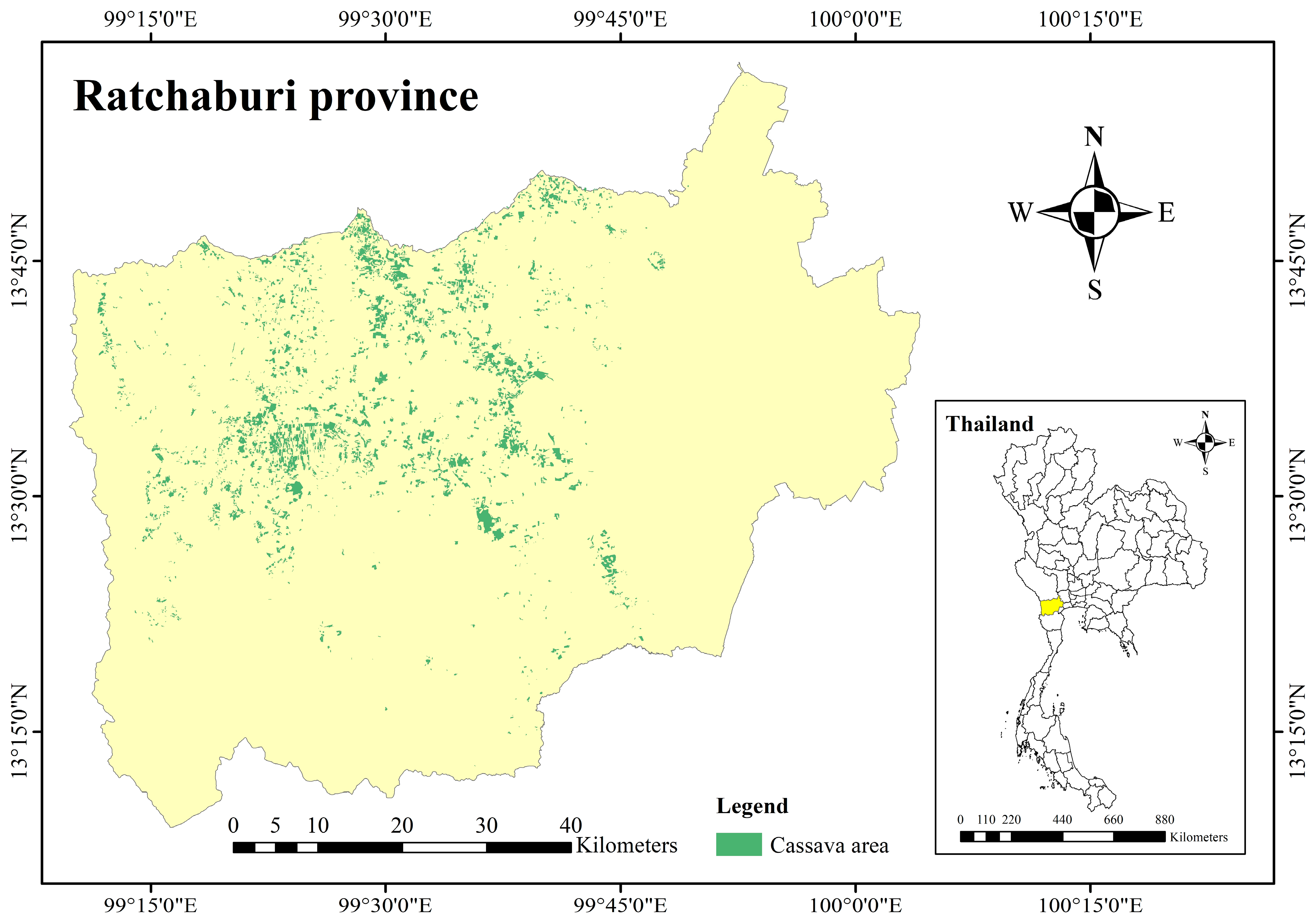

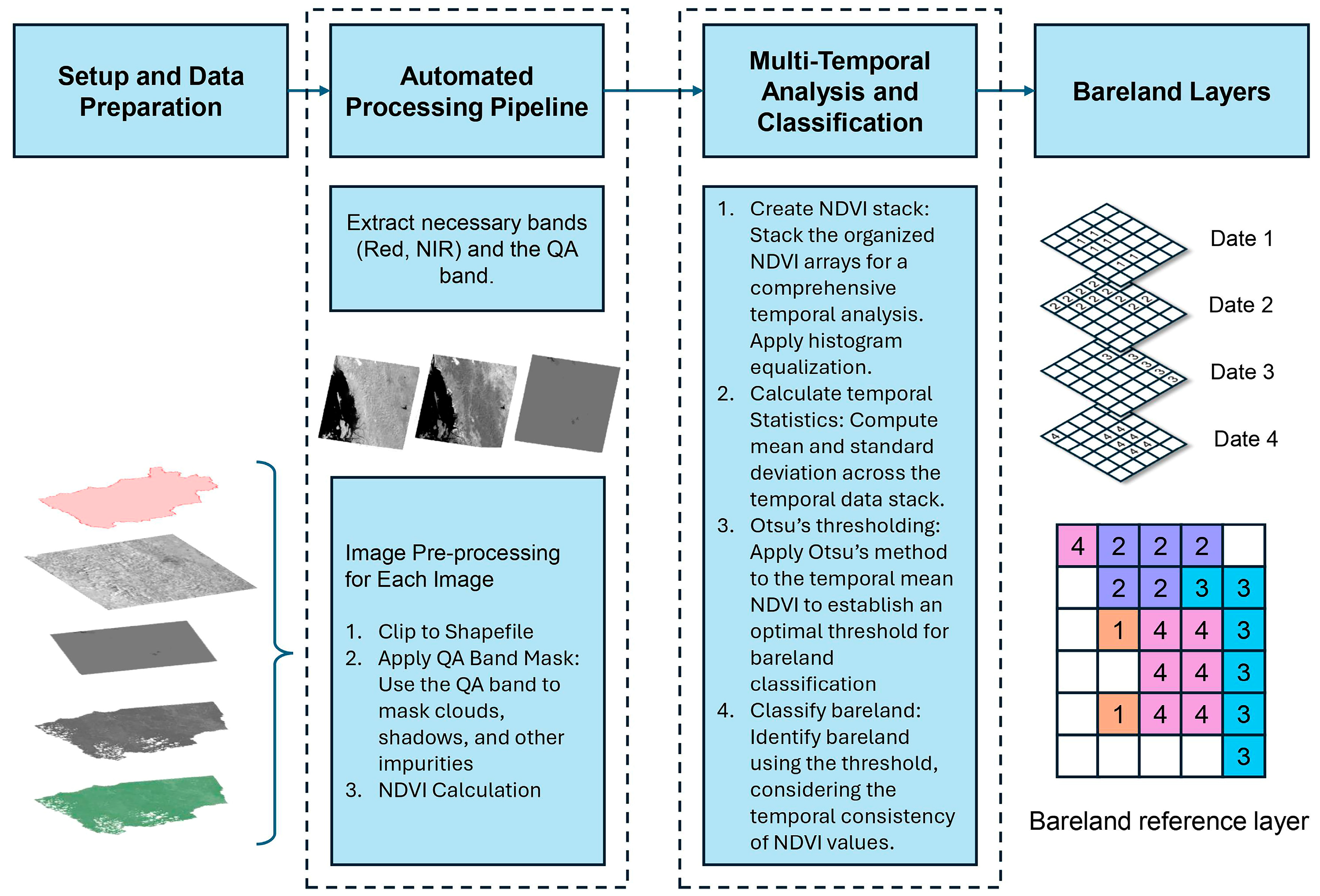

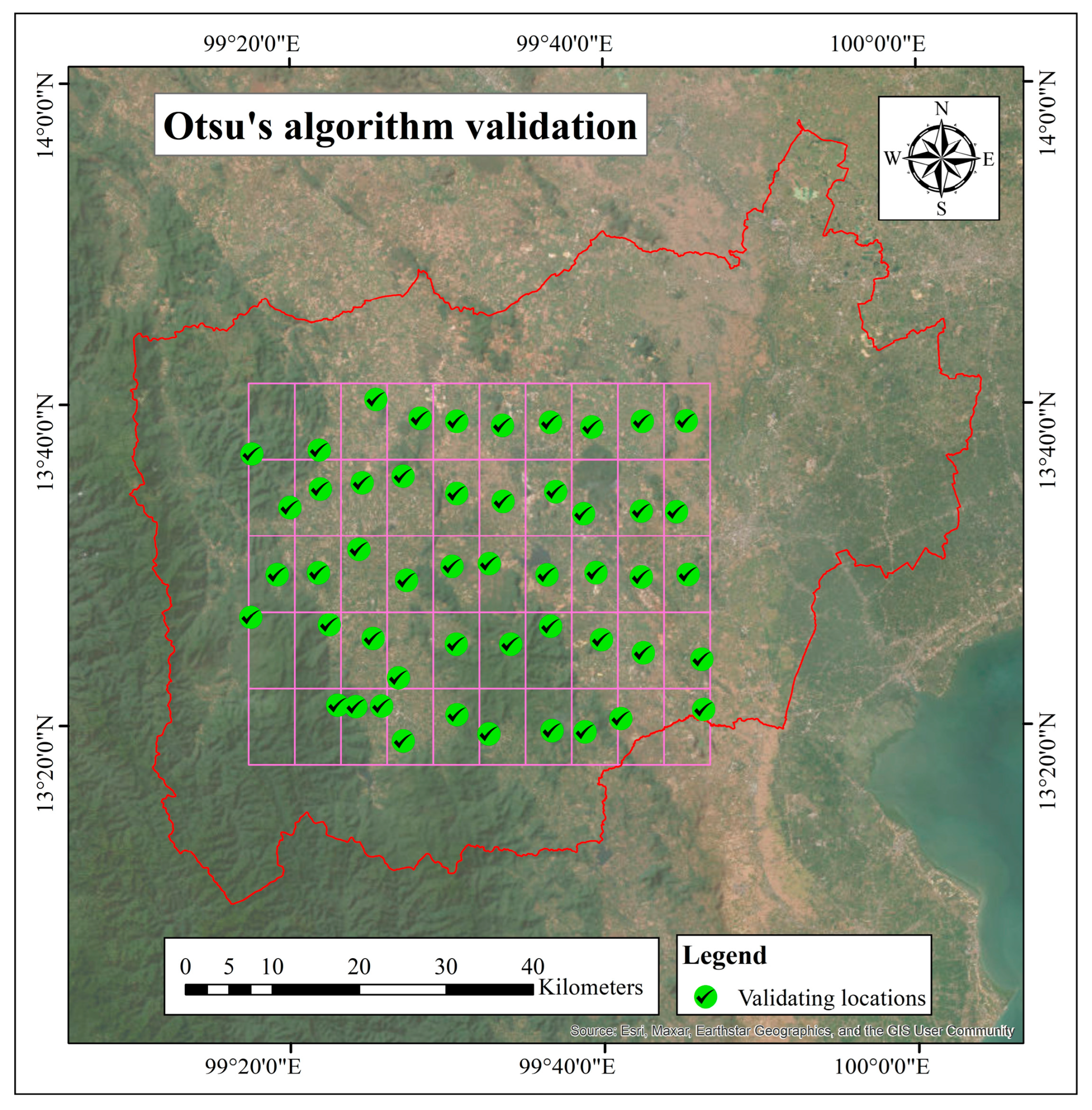


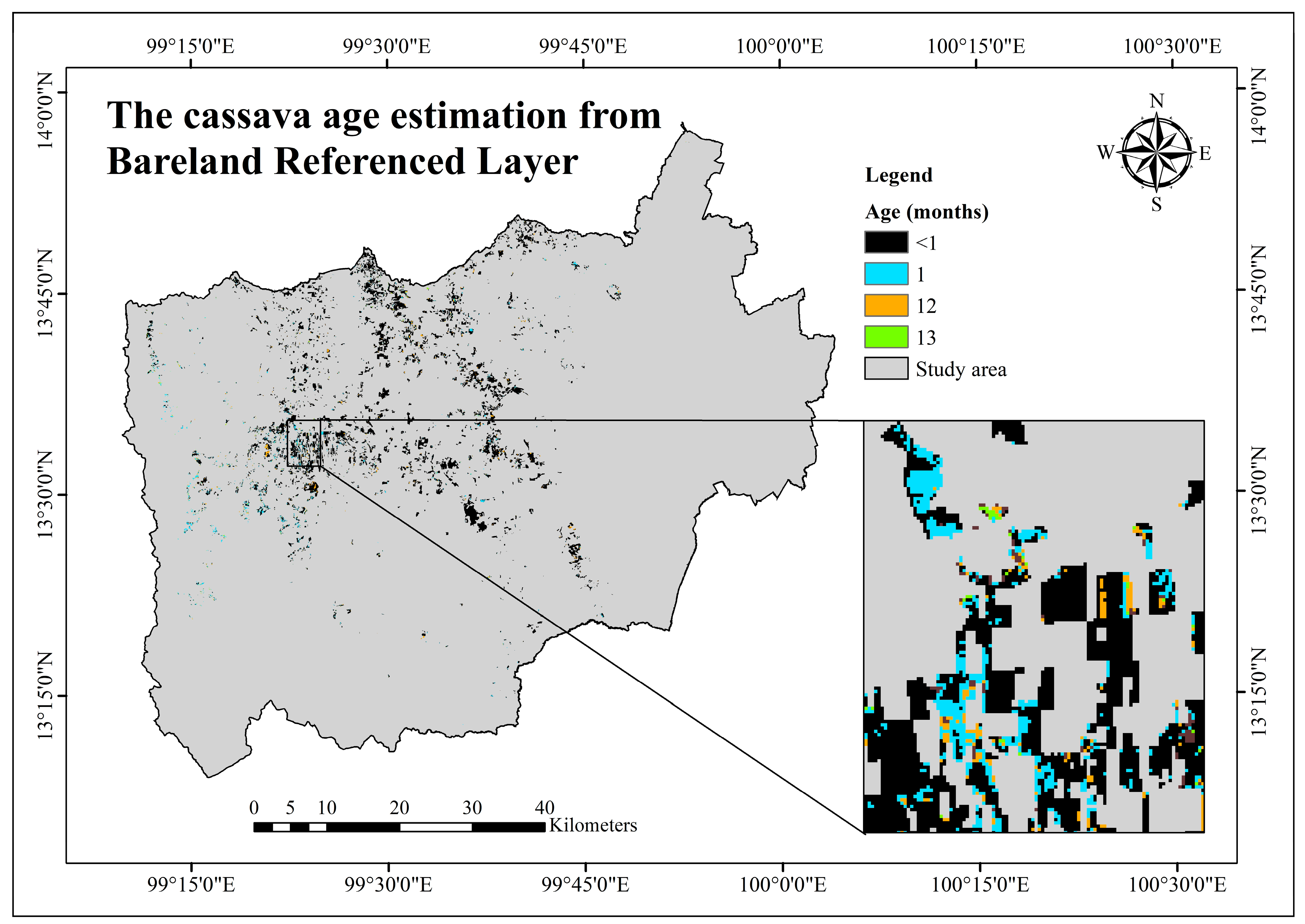

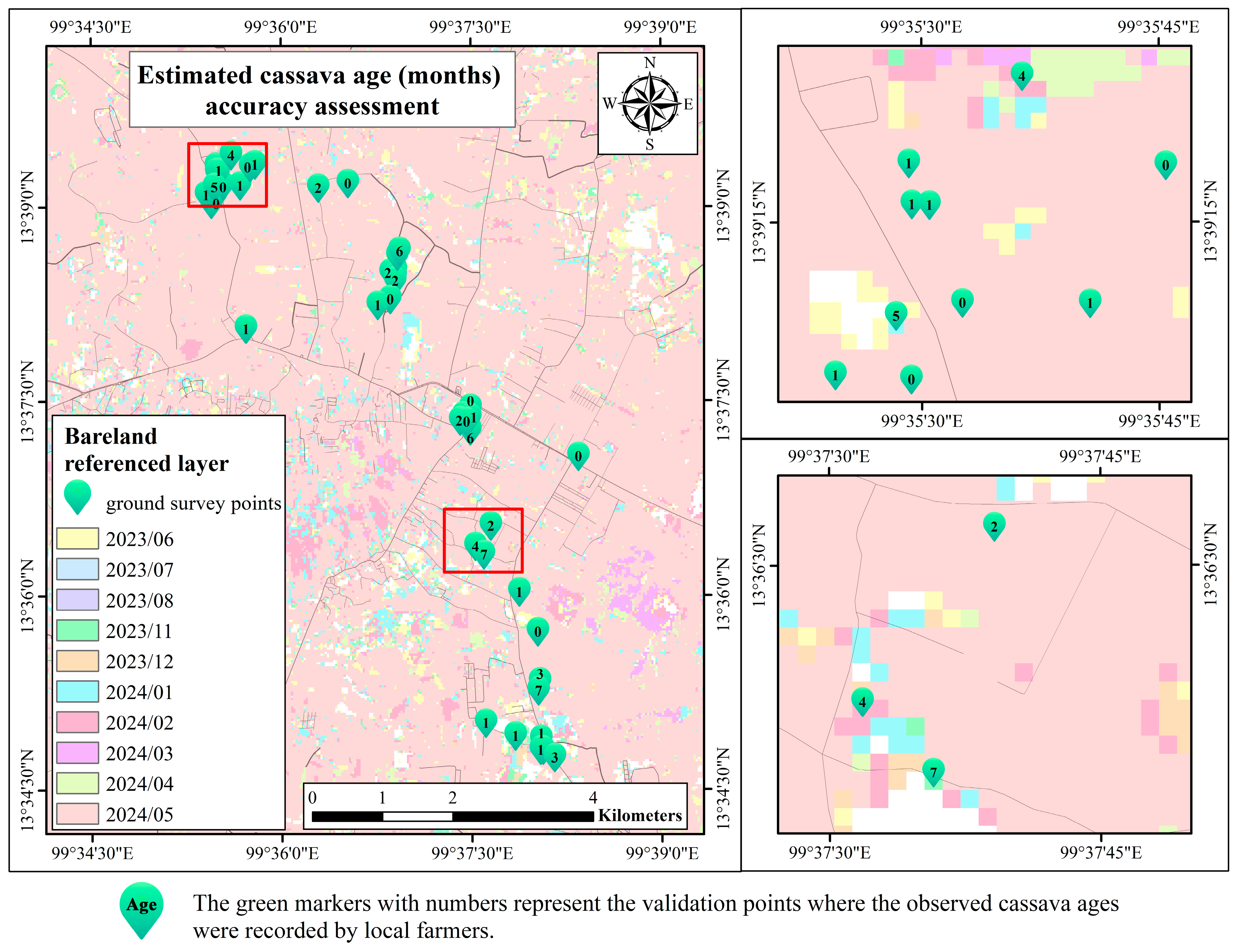
| Sensors | Path/Row | Quantities |
|---|---|---|
| Landsat 4 Thematic Mapper (TM) | 129/051 | 2 |
| Landsat 5 Thematic Mapper (TM) | 130/051 | 127 |
| 129/051 | 122 | |
| Landsat 7 Enhanced Thematic Mapper (ETM+) | 129/051 | 15 |
| 130/050 | 22 | |
| 130/051 | 17 | |
| Landsat 8 Operational Land Imager (OLI) | 129/051 | 74 |
| 130/050 | 81 | |
| 130/051 | 84 | |
| Landsat 9 Operational Land Imager (OLI) | 129/051 | 20 |
| 130/050 | 24 | |
| 130/051 | 16 | |
| Total | 604 |
| IDs | BR Layer Output Date | Validated * Bare Land Stage Date | Tradeoff | IDs | BR Layer Output Date | Validated * Bare Land Stage Date | Tradeoff |
|---|---|---|---|---|---|---|---|
| 1 | 11-May-2021 | 3-May-2021 | 8 | 26 | 17-Jan-2021 | 11-Jan-2021 | 6 |
| 2 | 19-Apr-2023 | 15-Apr-2023 | 4 | 27 | 17-Jan-2021 | 11-Jan-2021 | 6 |
| 3 | 8-Feb-2019 | 7-Feb-2019 | 1 | 28 | 5-Feb-2021 | 12-Feb-2021 | 7 |
| 4 | 8-Feb-2019 | 7-Feb-2019 | 1 | 29 | 5-Feb-2021 | 12-Feb-2021 | 7 |
| 5 | 17-Jan-2021 | 11-Jan-2021 | 6 | 30 | 5-Feb-2021 | 12-Feb-2021 | 7 |
| 6 | 17-Jan-2021 | 11-Jan-2021 | 6 | 31 | 6-Sep-2022 | 25-Jul-2022 | 43 |
| 7 | 17-Jan-2021 | 11-Jan-2021 | 6 | 32 | 12-May-2021 | 3-May-2021 | 9 |
| 8 | 5-Feb-2021 | 12-Feb-2021 | 7 | 33 | 12-May-2021 | 3-May-2021 | 9 |
| 9 | 5-Feb-2021 | 12-Feb-2021 | 7 | 34 | 12-May-2021 | 3-May-2021 | 9 |
| 10 | 5-Feb-2021 | 12-Feb-2021 | 7 | 35 | 17-Jan-2021 | 11-Jan-2021 | 6 |
| 11 | 19-Apr-2023 | 15-Apr-2023 | 4 | 36 | 17-Jan-2021 | 11-Jan-2021 | 6 |
| 12 | 2-Mar-2019 | 11-Mar-2019 | 9 | 37 | 17-Jan-2021 | 11-Jan-2021 | 6 |
| 13 | 1-Jan-2019 | 7-Feb-2019 | 37 | 38 | 24-Feb-2021 | 28-Feb-2021 | 4 |
| 14 | 1-Jan-2019 | 7-Feb-2019 | 37 | 39 | 24-Feb-2021 | 28-Feb-2021 | 4 |
| 15 | 17-Jan-2021 | 11-Jan-2021 | 6 | 40 | 23-Jan-2021 | 11-Jan-2021 | 12 |
| 16 | 17-Jan-2021 | 11-Jan-2021 | 6 | 41 | 5-Nov-2018 | 3-Nov-2018 | 2 |
| 17 | 17-Jan-2021 | 11-Jan-2021 | 6 | 42 | 5-Nov-2018 | 3-Nov-2018 | 2 |
| 18 | 17-Jan-2021 | 11-Jan-2021 | 6 | 43 | 12-May-2021 | 3-May-2021 | 9 |
| 19 | 16-Jan-2022 | 14-Jan-2022 | 2 | 44 | 12-May-2021 | 3-May-2021 | 9 |
| 20 | 5-Feb-2021 | 5-Feb-2021 | 0 | 45 | 27-Jun-2022 | 25-Jul-2022 | 28 |
| 21 | 19-Apr-2023 | 15-Apr-2023 | 4 | 46 | 27-Jun-2022 | 25-Jul-2022 | 28 |
| 22 | 19-Apr-2023 | 15-Apr-2023 | 4 | 47 | 24-Feb-2021 | 28-Feb-2021 | 4 |
| 23 | 12-May-2021 | 3-May-2021 | 9 | 48 | 24-Feb-2021 | 28-Feb-2021 | 4 |
| 24 | 12-May-2021 | 3-May-2021 | 9 | 49 | 5-Feb-2021 | 12-Feb-2021 | 7 |
| 25 | 17-Jan-2021 | 11-Jan-2021 | 6 | 50 | 5-Feb-2021 | 12-Feb-2021 | 7 |
| Average | 7.92 | Average | 9.64 | ||||
| Grand average | 8.78 | ||||||
| No. | Observed Age (Month) | Predicted Age (Month) | No. | Observed Age (Month) | Predicted Age (Month) | No. | Observed Age (Month) | Predicted Age (Month) |
|---|---|---|---|---|---|---|---|---|
| 1 | 1 | 1 | 15 | 2 | 1 | 29 | 1 | 1 |
| 2 | 1 | 1 | 16 | 0 | 1 | 30 | 2 | 1 |
| 3 | 1 | 1 | 17 | 0 | 1 | 31 | 1 | 1 |
| 4 | 0 | 1 | 18 | 6 | 6 | 32 | 3 | 3 |
| 5 | 0 | 1 | 19 | 2 | 1 | 33 | 1 | 1 |
| 6 | 1 | 1 | 20 | 1 | 1 | 34 | 1 | 1 |
| 7 | 1 | 1 | 21 | 2 | 1 | 35 | 5 | 5 |
| 8 | 1 | 1 | 22 | 2 | 1 | 36 | 0 | 1 |
| 9 | 0 | 1 | 23 | 4 | 4 | 37 | 1 | 1 |
| 10 | 0 | 1 | 24 | 7 | 7 | 38 | 4 | 4 |
| 11 | 5 | 5 | 25 | 1 | 1 | 39 | 1 | 1 |
| 12 | 1 | 1 | 26 | 0 | 1 | 40 | 2 | 2 |
| 13 | 2 | 1 | 27 | 3 | 3 | 41 | 6 | 6 |
| 14 | 1 | 1 | 28 | 7 | 7 | 42 | 1 | 1 |
| 43 | 0 | 1 |
Disclaimer/Publisher’s Note: The statements, opinions and data contained in all publications are solely those of the individual author(s) and contributor(s) and not of MDPI and/or the editor(s). MDPI and/or the editor(s) disclaim responsibility for any injury to people or property resulting from any ideas, methods, instructions or products referred to in the content. |
© 2024 by the authors. Licensee MDPI, Basel, Switzerland. This article is an open access article distributed under the terms and conditions of the Creative Commons Attribution (CC BY) license (https://creativecommons.org/licenses/by/4.0/).
Share and Cite
Boonprong, S.; Satapanajaru, T.; Piolueang, N. Advancing Cassava Age Estimation in Precision Agriculture: Strategic Application of the BRAH Algorithm. Agriculture 2024, 14, 1075. https://doi.org/10.3390/agriculture14071075
Boonprong S, Satapanajaru T, Piolueang N. Advancing Cassava Age Estimation in Precision Agriculture: Strategic Application of the BRAH Algorithm. Agriculture. 2024; 14(7):1075. https://doi.org/10.3390/agriculture14071075
Chicago/Turabian StyleBoonprong, Sornkitja, Tunlawit Satapanajaru, and Ngamlamai Piolueang. 2024. "Advancing Cassava Age Estimation in Precision Agriculture: Strategic Application of the BRAH Algorithm" Agriculture 14, no. 7: 1075. https://doi.org/10.3390/agriculture14071075
APA StyleBoonprong, S., Satapanajaru, T., & Piolueang, N. (2024). Advancing Cassava Age Estimation in Precision Agriculture: Strategic Application of the BRAH Algorithm. Agriculture, 14(7), 1075. https://doi.org/10.3390/agriculture14071075









